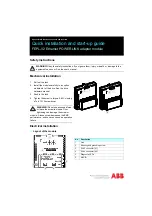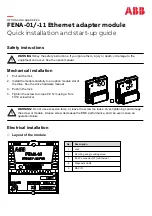
Subject to change_SD1EX-A2(A3)_14088_1en_05/2022
Page 9
www.argo-hytos.com
The hydraulic part of the valve consists of a steel housing (A) with radial inlets of channel 2 and axial outlets of channel 1. A hardened cone moves
inside the seat and is held in its basic position by a return spring. The cone is repositioned by fluid pressure after opening/closing the control stage,
operated by an explosion-proof certified solenoid (B). The solenoid coil is fixed to the control system by a special nut (C).
The valves close and seal in both directions of the working fluid flow. It is therefore permissible to interchange the inlet and outlet channels.
DANGER
Electrical shock
The solenoid coil is an electrical device that should be connected by a person with appropriate electrical
qualifications. Before connecting the solenoid, check the parameters of the power supply, the integrity of the
cable and the solenoid. There is a threat of electrical shock.
CAUTION
Electrical supply values
The solenoid coil is energised by the electrical current passing through the winding. The values of the electrical
supply must not exceed the values indicated on the coil. There is a risk of losing solenoid function.
3.3 Risks associated with the electrical part of the valve
4.
Product description
1
2
A
B
C
Valve SD1EX-A2
1
2 3
1
2
Valve SD1EX-A3
1
2
2S5
2S6
CAUTION
Maximum operating temperature
The maximum operating temperature must not exceed the temperature range allowed in paragraph 4.4 Basic
technical parameters or in the product catalogue. Both the temperature of the operating fluid and the ambient
temperature significantly influence:
a)
the surface temperature of the valve
b)
the temperature of the solenoid coil winding - there is a risk of a reduction in hydraulic performance
c)
the seal material - risk of seal damage and leakage of the working fluid.
CAUTION
Surface temperature of the valve
The surface temperature of the valve can exceed 100 °C due to the temperature of the working fluid and pressure
loss in the valve being converted to heat. Do not touch the surface of the valve when the circuit is operational,
even after switching off. Wait until it has cooled down to a safe temperature. There is a risk of burns.
CAUTION
Working fluids used
Valves may only be used for normal working fluids, especially hydraulic oils (see chapter 4. Product description).
It is forbidden to use the following as working fluids, in particular:
›
water and aquesous solutions that will cause corrosion and loss of valve function
›
liquids which are flammable or explosive, the heating of which may cause fire or explosion when
passing through the valve
›
aggresive liquids (e.g. acids and hydroxides) which will cause damage to the valve and loss of function.
The flash point of the used working fluid must be at least 50 K higher than the maximum allowed of surface
temperature of the valve in the given temperature class.
2
3 1
Summary of Contents for SD1EX-A2
Page 3: ...Subject to change_SD1EX A2 A3 _14088_1en_05 2022 Page 3 www argo hytos com...
Page 4: ...Subject to change_SD1EX A2 A3 _14088_1en_05 2022 Page 4 www argo hytos com...
Page 23: ...N vod k pou it _SD1EX A2 A3 _14088_1cz_05 2022 Strana 2 www argo hytos com Prohl en o shod...
Page 24: ...N vod k pou it _SD1EX A2 A3 _14088_1cz_05 2022 Strana 3 www argo hytos com...
Page 25: ...N vod k pou it _SD1EX A2 A3 _14088_1cz_05 2022 Strana 4 www argo hytos com...










































